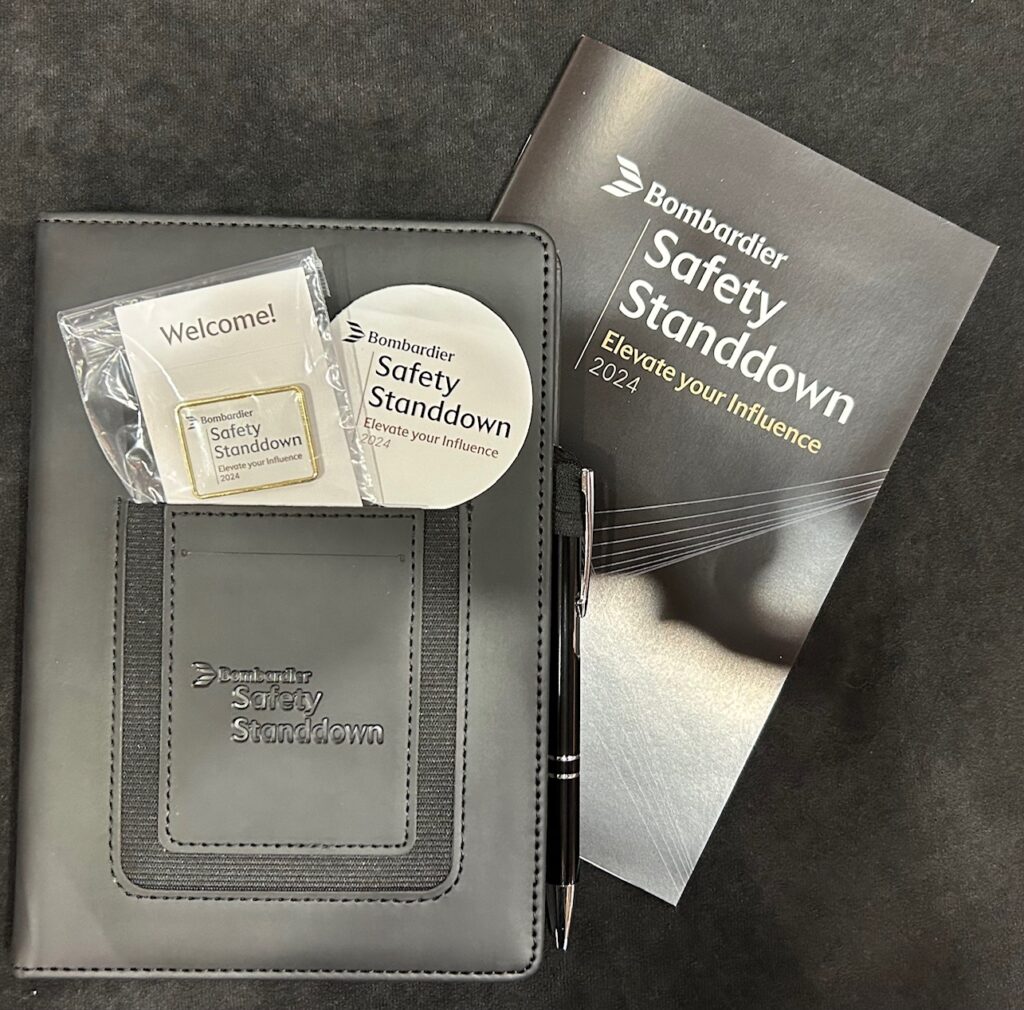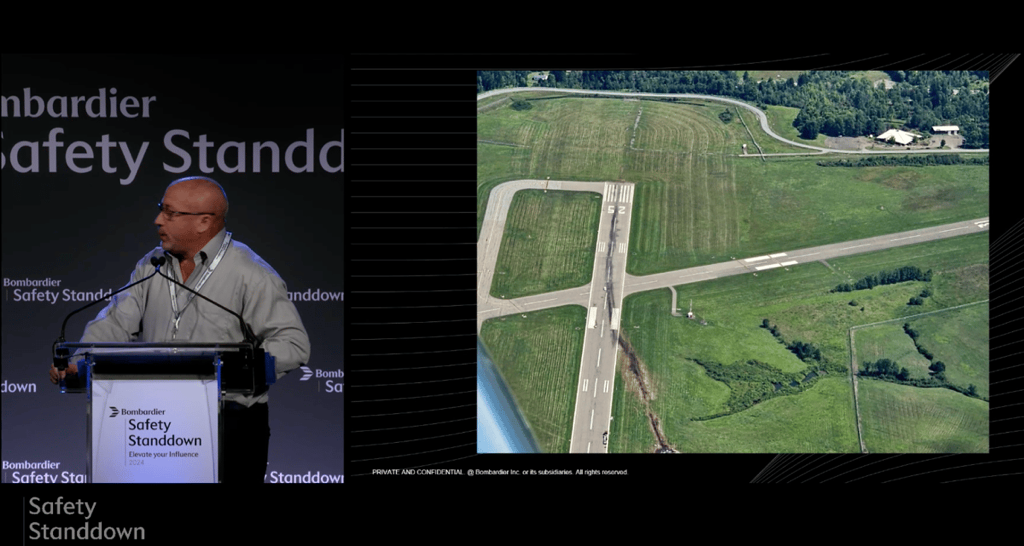
FLYING LESSONS uses recent mishap reports to consider what might have contributed to accidents, so you can make better decisions if you face similar circumstances. In most cases design characteristics of a specific airplane have little direct bearing on the possible causes of aircraft accidents—but knowing how your airplane’s systems respond can make the difference in your success as the scenario unfolds. So apply these FLYING LESSONS to the specific airplane you fly. Verify all technical information before applying it to your aircraft or operation, with manufacturers’ data and recommendations taking precedence. You are pilot in command and are ultimately responsible for the decisions you make.
FLYING LESSONS is an independent product of MASTERY FLIGHT TRAINING, INC.
Pursue Mastery of Flight™
This week’s LESSONS
This week I’m attending the Bombardier Safety Standdown, an annual gathering of aviation safety experts, pilots, mechanics and others primarily in business and corporate aviation. This is the 28th annual Standdown and the fifth time I’ve attended. Although I’m not employed in business jet aviation, the Standdown’s main audience, I know several of the regular speakers and frequently run across others from my end of the aviation spectrum. I get great inspiration from the presentations that I take back to my work and also apply to my after-hours activities here toward Mastery of Flight(TM).

In the opening session Tuesday one of the speakers was Citation X pilot Kevin Van Splunder. His short but riveting presentation described his experience in a fiery crash of the large corporate jet that began with the scenario we discussed in last week’s LESSONS: an unusual smell in the cockpit.

AINOnline photo
As I listened I lamented that I was unable to capture his experience in a way I could relate here to you. Happily I find today that Matt Thurber of AINOnline has documented Van Splunder’s narrative in this article. You’ll read about the airplane’s response to the initial fault, its dizzying plummet to earth and how the crew amazingly put the jet down on a runway under control and how he and the captain escaped the burning aircraft.
More importantly, Van Splunder credits the training he received from “old codgers” that gave him the mindset and skills he needed to survive. Because it’s a valuable LESSON, and because it builds on last week’s LESSONS, read Matt Thurber’s documentation of Kevin Van Splunder’s presentation.
Questions? Comments? Supportable opinions? Let us know at [email protected].

Debrief
Readers write about past FLYING LESSONS
Continuing last week’s LESSONS about responding to hazardous smells in the cockpit, readers relate their experiences. Wendell Todd writes:
Over the years, several times I have smelled the odor of wood burning when near a forest fire. Absent a forest tire, the only time I smelled fumes in flight was a false alarm. The occurrence was at dusk on final approach to Runway 2 at KHRX (Hereford, Texas, in Deaf Smith County). The smell was distinctly that of burning wood. My [Beech] Debonair’s only wood is in the floorboards, which I checked, finding no fire.
The explanation for the fumes seems to be from an electricity-generating burn facility near the stockyards south of the airport. The false alarm was both unnerving and memorable.
I’ve experienced similar many times. Out here in the Great Plains controlled burns of fields is routine in the fall and grassland fires are common. When providing instrument instruction I warn pilots who are “under the hood” when we’re about to enter an area of smoke so they don’t think we have a fire on board. Even then, it’s a little unnerving to me to smell smoke in the cockpit. Thank you, Wendell.
Reader Pat O’Brien adds:
Early in my flying career I was flying for a small avionics company. The plane for shop visits across the US was an Aero Commander 200 owned personally by the company owners and leased back to the company. There was lots of pressure to keep flying. I was out for a week of visits and smelled fuel in the cockpit. Put plane down in Little Rock [Arkansas] to investigate. The owners were not happy with my decision to not continue to fly. That was when I realized I needed to go work somewhere else. Unfortunately, that somewhere else was a non-aviation position and I didn’t fly for 25 years. That wasn’t the intent, it just happened. But the return to flying has been the best with 3,500 hours (1,000 before I stopped) and 50 different airplane types. We should stress to pilots to not be forced to fly airplanes until issues are resolved.
Sorry you had to leave your job over a safety decision, Pat. That seems all too common in aviation. You’re exactly right—for safety, and also the widespread acceptance of lightplane aviation, we need to get our priorities straight. Thank you.
Reader Art Utay relates his experience:
My cockpit smell story:
Several months ago, I was cruising around in my F33A [Bonanza] when the smell of burning plastic became strong in the cockpit. I immediately looked over at the avionics stack and noticed the display on the #2 navcom (GNS430) was winking out. I shut the unit off and opened the overhead air vents. The smell subsided and I landed uneventfully.
The navcom was inspected and bench tested. No discrepancies were found, A deep dive of the wiring behind the panel didn’t reveal any anomalies. The unit was reinstalled. One hundred plus hours later, there’s been no recurrence of the smell, the GNS has worked flawlessly, and I’ve been unable to explain what caused the original issue.
Very strange, Art. Transient or intermittent issues are the hardest to address.
Reader Gary Palmer goes back on week further to add to my October 31 LESSONS about ramp safety and aircraft marshallers:
I read your article and thought about the Young Eagle events where I am a pilot and marshallers stand right in front of my airplaneto guide me in and signal shutdown. I would say they are maybe 10 feet in front of the prop when I shut down and it has always made me nervous.
I read Brian Sagi’s response this week and decided it is time for action. I wrote to the coordinators of Young Eagles for the chapters I fly for asking they instruct marshallers to stand off to the side. Then I started writing this note to thanks you and Brian. But I realize this is bigger, so I am writing to EAA Young Eagles to request a change.
Here is whom I am writing to and what I wrote. If EAA hears this from a larger group I believe they would feel the weight of making things safer.
————————————————————————————————-
Subject: Safety concern that can be fixed
Dear EAA Young Eagles,
I have had concerning experiences as a pilot flying at Young Eagle events. My concern is about the safety of aircraft marshallers. I fly a small single engine and the marshallers stand DIRECTLY in front of my aircraft and signal shutdown when there is less than 10 feet between he and my spinning prop. This has bothered me for a while but can now voice why.
I suggest you provide the following FAA AC regarding how to marshal and specifically where to stand (reference page 16): https://www.faa.gov/documentLibrary/media/Advisory_Circular/AC_00-34B.pdf
For a more complete story which was my motivation, read the very short “This Weeks’s Lessons” article at:
https://thomaspturner.com/flying-lessons-weekly/flying-lessons-for-october-31-2024/.
I am suggesting that all YE coordinators have a short briefing for the marshallers at their events to inform them of the SAFE way to marshal aircraft. Possibly add to the online training that all of us must complete in order to participate in YE events!
————————————————————————————————-
I can be thankful we have not had an accident at a YE event yet, but we can be safer to avoid ever having one! Thank you.
Outstanding, Gary. Thank you. Several senior EAA officers and board members read FLYING LESSONS, including the Vice President for Safety and the Safety Committee Chairman. Please let me know what response you get.
More to say? Let us learn from you, at [email protected]

Share safer skies. Forward FLYING LESSONS to a friend.
Please help cover the ongoing costs of providing FLYING LESSONS through this secure PayPal donations link. Or send a check made out to Mastery Flight Training, Inc. at 247 Tiffany Street, Rose Hill, Kansas USA 67133. Thank you, generous supporters.
Thank you to our regular monthly financial contributors:
Steven Bernstein, Montclair, NJ. Robert Carhart, Jr., Odentown, MD. Randy Carmichael, Kissimmee, FL. Greg Cohen, Gaithersburg, MD. John Collins, Martinsburg, WV. Dan Drew. Rob Finfrock, Rio Rancho, NM. Norman Gallagher. Bill Griffith, Indianapolis, IN. Steven Hefner, Corinth, MS; Ellen Herr, Ft Myers, FL. Erik Hoel, Redlands, CA. Ron Horton. David Karalunas, Anchorage, AK. Steve Kelly, Appleton, WI. Karl Kleiderer. Greg Long, Johnston, IA. Rick Lugash, Los Angeles, CA. Richard McCraw, Hinesburg, VT. David Ovad, Resiertown, MD. Steven Oxholm, Portsmouth, NH. Brian Schiff, Keller, TX. Paul Sergeant, Allen, TX. Paul Uhlig, Wichita, KS. Richard Whitney, Warrenton, VA. Jim Preston, Alexandria, VA. Johannes Ascherl, Munich, Germany. Bruce Dickerson, Asheville, NC. Edmund Braly, Norman, OK. Steven Hefner. Lorne Sheren, New Vernon, NJ. “The Proficient Pilot,” Keller, TX. Ed Stack, Prospect Heights, IL. Kynan Sturgiss, Hereford, TX
And thanks to these donors in 2024:
Jim Lara, Joseph Stadelmann, Dixon Smith, Barry Warner, Wayne Mudge, Joseph Vandenbosch, Ian Campbell, Jay Apt, John Kimmons, Derek Rowan, Michael Maya Charles, Ron Horton, Lauren McGavran, Gerald Magnoni, Amy Haig, Rod Partlo, Brent Chidsey, Mard Sasaki-Scanlon, SABRIS Aviation (Dave Dewhirst), Edmund Braly, Joseph Orlando, Charles Lloyd, Michael Morrow, Abigail Dang, Thomas Jaszewski Danny Kao, Gary Garavaglia, Brian Larky, Glenn Yeldezian, David Yost, Charles Waldrop, Robert Lough. Gilbert Buettner. Panatech (Henry Fiorientini). Dale Bleakney. Mark Kolesar. John Winter. Donald Bowles. David Peterson. Bill Abbatt. Bruce Jacobsen. Denny Southard. Wayne Cloburn. Ross Ditlove. “Bonanza User,” Tad Santino, Steven Scharff, Kim Caldwell
Pursue Mastery of Flight(TM)
Thomas P. Turner, M.S. Aviation Safety
Flight Instructor Hall of Fame Inductee
2021 Jack Eggspuehler Service Award winner
2010 National FAA Safety Team Representative of the Year
2008 FAA Central Region CFI of the Year
FLYING LESSONS is ©2024 Mastery Flight Training, Inc. For more information see www.thomaspturner.com. For reprint permission or other questions contact [email protected].

